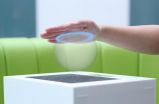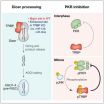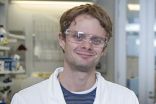See it, touch it, feel it
2014-12-02
(Press-News.org) Technology has changed rapidly over the last few years with touch feedback, known as haptics, being used in entertainment, rehabilitation and even surgical training. New research, using ultrasound, has developed an invisible 3D haptic shape that can be seen and felt.
The research paper, published in the current issue of ACM Transactions on Graphics and which will be presented at this week's SIGGRAPH Asia 2014 conference [3-6 December], demonstrates how a method has been created to produce 3D shapes that can be felt in mid-air.
The research, led by Dr Ben Long and colleagues Professor Sriram Subramanian, Sue Ann Seah and Tom Carter from the University of Bristol's Department of Computer Science, could change the way 3D shapes are used. The new technology could enable surgeons to explore a CT scan by enabling them to feel a disease, such as a tumour, using haptic feedback.
The method uses ultrasound, which is focussed onto hands above the device and that can be felt. By focussing complex patterns of ultrasound, the air disturbances can be seen as floating 3D shapes. Visually, the researchers have demonstrated the ultrasound patterns by directing the device at a thin layer of oil so that the depressions in the surface can be seen as spots when lit by a lamp.
The system generates an invisible 3D shape that can be added to 3D displays to create something that can be seen and felt. The research team have also shown that users can match a picture of a 3D shape to the shape created by the system.
Dr Ben Long, Research Assistant from the Bristol Interaction and Graphics (BIG) group in the Department of Computer Science, said: "Touchable holograms, immersive virtual reality that you can feel and complex touchable controls in free space, are all possible ways of using this system.
"In the future, people could feel holograms of objects that would not otherwise be touchable, such as feeling the differences between materials in a CT scan or understanding the shapes of artefacts in a museum."
INFORMATION:
Paper
Rendering Volumetic Haptic Shapes in Mid-Air using Ultrasound by Benjamin Long, Sue Ann Seah, Tom Carter, Sriram Subramanian in ACM Transactions on Graphics.
A short video of the technology is available on YouTube at: http://youtu.be/4O94zKHSgMU
[Attachments] See images for this press release:

ELSE PRESS RELEASES FROM THIS DATE:
2014-12-02
Parents and family make all the difference in creating the next generation of scientists, engineers and mathematicians, according to new research by George Mason University.
"We were surprised to learn that the family is more important than we ever thought in terms of igniting the passion of future scientists," says Lance Liotta, a study author and co-director of George Mason's Center for Applied Proteomics and Molecular Medicine.
The study, featured in CBE-Life Sciences Education, is the first peer-reviewed article of its kind to focus on what initially attracts young ...
2014-12-02
AMHERST, Mass. - Using a new approach for determining the age at sexual maturity for wild stocks of western Atlantic bluefin tuna, researchers led by Molly Lutcavage of the University of Massachusetts Amherst and Gilad Heinisch of Israel's Oceanographic and Limnological Research Center, suggest that these fish mature at a considerably younger age than cuurently assumed. These findings could lead to changes in how fisheries scientists estimate the population.
Lutcavage says, "Whether a bluefin tuna or cod, for realistic fish stock assessments it's important to know at ...
2014-12-02
December 2, 2014 - Now you don't even have live in Estonia to open a business there. A new program lets people purchase e-signatures that enable them to open bank accounts and run a domestic business without being physically present. But according to new research, people may not have the same trust in such businesses as they would others. A new paper finds that people are much more likely to discount the validity of an e-signature than a hand-signed document.
"Although e-signatures provide greater efficiency and convenience, they just seem a bit inauthentic," says Eileen ...
2014-12-02
LOS ANGELES (Dec. 1, 2014) - Research scientists have developed a novel method to re-create brain and intestinal stem cells from patients who died decades ago, using DNA from stored blood samples to study the potential causes of debilitating illnesses such as inflammatory bowel disease.
The lab research, published in the journal STEM CELLS Translational Medicine, could yield new therapies for people who suffer from aggressive motor-neuron and gut-related conditions that proved fatal to the deceased patients who long-ago volunteered their blood samples.
"The potential ...
2014-12-02
Philadelphia, PA, December 1, 2014 - "Triple-negative" breast cancer (TNBC) occurs in patients whose cells do not express receptors for estrogen, progesterone, and/or human epidermal growth factor receptor 2 (ER/PR/HER2). Because of the absence of these predictive biomarkers, treatment assignment can be difficult. Now, researchers report that high levels of the microRNA miR-21 in the tumor microenvironment, but not in the tumor epithelia (cancer cells), are associated with worse clinical outcomes for patients with TNBC, thus identifying a possible ...
2014-12-02
Research at the University of Adelaide has discovered cancer cells may be particularly susceptible to metabolic stress - opening the way for new targeted therapy that won't harm normal cells.
The researchers showed that chromosomal instability - which is a hallmark of rapidly dividing cancer cells - makes them stressed and vulnerable to mild metabolic disruption. Metabolism is the normal process by which the body turns food into energy.
"A common problem in treating cancers is that they don't respond to chemotherapy, or they respond for a while, but then come back," ...
2014-12-02
The research team of the Center for RNA Research at IBS has succeeded in revealing that the dsRNAs and Protein Kinase R (PKR) regulate division of mammalian cells.
This finding will provide important clues to understanding the process of tumor formation and the mechanism for suppressing cancer since the abnormal cell division marks the early events of cancer development.
For the first time, the IBS research team has found that during mitosis, the cellular dsRNAs activate PKR, an enzyme previously known as a trigger of immune response during virus infection. Activated ...
2014-12-02
Inflammatory skin diseases such as psoriasis may result from abnormal activation of cell death pathways previously believed to suppress inflammation, a surprise finding that could help to develop new ways of treating these diseases.
Mr James Rickard, Associate Professor John Silke and colleagues from the Walter and Eliza Hall Institute made the discovery while investigating how cell death pathways are linked to inflammatory disease development. The study was published today in the journal eLife.
Infected cells, cancerous cells, or those that are simply unnecessary to ...
2014-12-02
Vitamin D deficiency is not just harmful to physical health--it also might impact mental health, according to a team of researchers that has found a link between seasonal affective disorder, or SAD, and a lack of sunlight.
"Rather than being one of many factors, vitamin D could have a regulative role in the development of SAD," said Alan Stewart of the University of Georgia College of Education.
An international research partnership between UGA, the University of Pittsburgh and the Queensland University of Technology in Australia reported the finding in the November ...
2014-12-02
URBANA, Ill. - A 12-year University of Illinois study shows that, although the use of cover crops does not improve crop yields, the practice does increase the amount of sequestered soil organic carbon using three different soil management systems.
U of I soil scientist Ken Olson evaluated plots that were subjected to no-till, chisel plow and moldboard plow treatments with and without hairy vetch and cereal rye cover crops.
"By 2012, we found that the soil tillage plots that had cover-crop treatments had more soil organic carbon stock than those without cover crops ...
LAST 30 PRESS RELEASES:
[Press-News.org] See it, touch it, feel it




